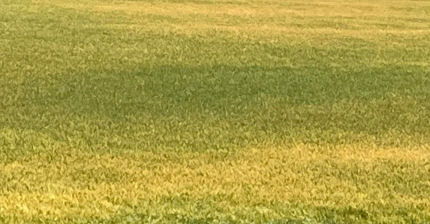Kansas’ wheat quality is estimated to be above average and high in protein this year because of a lack of rain, according to Farmers Business Network’s senior commodity analyst Rejeana Gvillo.
Such findings from a mid-May wheat tour through Kansas conducted by the Wheat Quality Council are the good news. The bad news is an estimated 100 million bushel drop in wheat yield production for the state, according to U.S. Sen. Roger Marshall as he testified before the Senate Agriculture Committee in Washington, D.C., last week.
“I think that about 30% of our average yield is going to be impacted by drought this year,” Marshall said. “That’s a value of over a billion dollars to the state of Kansas.”
A persistent La Niña weather pattern that has failed to give way over the past three years facilitates hotter and drier weather conditions for the United States’ key production areas, according to Gvillo.
On the other hand, the dry weather has produced perfect conditions for little pest and fungus damage, resulting in higher quality wheat. Millers tend to pay more for higher quality wheat, according to Kansas State University.
“The only time I got moisture on my pants was the Wichita to Manhattan stops, so twice,” Gvillo said while talking about the wheat tour stops. “And normally, you’d have to wear rain pants, because you’re gonna get wet from all the dew, and that was never a problem.”
The wheat tour estimates Kansas will harvest 39.7 bushels per acre, while last year it was estimated significantly higher at 47.4 bushels per acre. The USDA’s 2022 winter wheat production forecast estimates U.S. production will be 8% lower than in 2021. This year’s wheat harvest could be the third-smallest crop over the course of the last 20 years, according to FBN.
Conditions are not uniform across the state. Marshall said that half of Kansas is designated as a moderate drought area, while over a third of the state is designated as a severe drought area.
“As we moved further west, the fields got thinner, the stands are poor, the plants themselves shorter,” Gvillo said. “And as we moved south that got further exacerbated, and then as we moved back east, the crop started looking better and better.”

According to FBN, growing conditions in northeast Kansas have been mostly normal, as conditions are about average for this time of year. In addition to dry spring months, the lack of precipitation during winter months facilitated poor growth in southwest Kansas.
“We don’t expect a lot of moisture over the winter, but we really didn’t get much of any snow,” said Daryl Strouts, CEO and president of Kansas Wheat Alliance. “So that kind of left the wheat in a tough state, and the wheat didn’t even germinate. Like in southwest Kansas, it was so dry that the wheat didn’t even germinate, it didn’t even come up in some places.”
Strouts said this year’s wheat in southwest Kansas is some of the shortest he has ever seen. He believes a lot of it will be too short for combines to harvest the crop.
FBN polling shows a higher number of claims of total crop losses from the network’s farmers, which suggest there will be more abandoned wheat acres this year than average. Gvillo partially blames this on short wheat crops.
“It’s not unusual to have an extended drought, especially in the western part of the state, but this year it really affected the central part of the state, and that is pretty unusual,” Strouts said.
Gvillo said this year’s decline in U.S. wheat production comes at a troubling time, as wheat exports from Ukraine — one of the world’s leading wheat exporters — have plummeted and prices have increased because of the Russian invasion. India — another wheat exporting country — is facing blows to its wheat production because of extreme heat waves, according to Reuters.
Kansas’ challenges with wheat production will have an extreme effect on the United States, as Kansas ranks first amongst states in wheat production, according to the USDA. Oklahoma and Texas — both experiencing droughts — rank second and third respectively.
A better understanding of U.S. wheat harvest will become available June 30, after the USDA releases a harvest report.
_ _ _
Lily O’Shea Becker / Kansas Reflector



